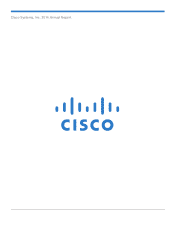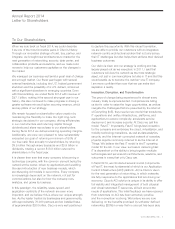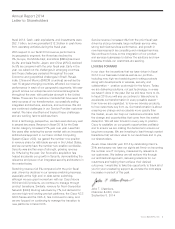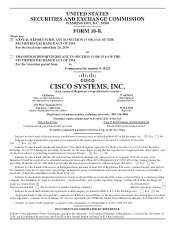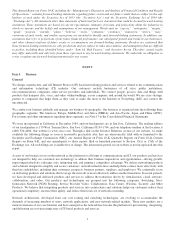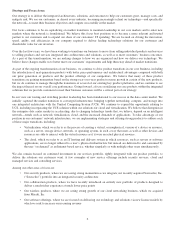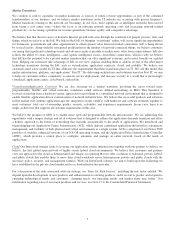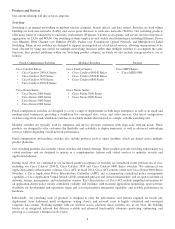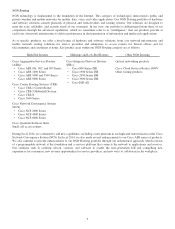Cisco 2014 Annual Report Download - page 3
Download and view the complete annual report
Please find page 3 of the 2014 Cisco annual report below. You can navigate through the pages in the report by either clicking on the pages listed below, or by using the keyword search tool below to find specific information within the annual report.
Cisco Systems, Inc. 1
Annual Report 2014
Letter to Shareholders
To Our Shareholders,
When we look back on scal 2014, we could describe
it as one of the most innovative years in Cisco’s history.
Through our innovation strategy of build, buy, partner, and
integrate, we brought new architectures to market for the
next generation of networking, security, data center, and
collaboration products and solutions, and we made bold
moves to help our customers capitalize on the changes in
the market.
We managed our business well amid a great deal of change
and a tough market. Our scal year began with several
external headwinds, including the U.S. federal government
shutdown and the possibility of a U.S. default, combined
with a signicant slowdown in emerging countries. Even
with this backdrop, we ended scal 2014 with revenue of
$47.1 billion, making it the second strongest year in our
history. We also continued to make progress in driving a
greater software mix and higher recurring revenue, which
are key pillars of our strategy.
We remain focused on shareholder value creation by
maintaining the exibility to make the right long-term
strategic decisions for our company, driving eciencies
in our cost structure and returning capital through
dividends and share repurchase to our shareholders.
During scal 2014 we delivered strong operating margins.
Additionally, we were very pleased to have substantially
exceeded our goal of returning a minimum of 50% of
our free cash ow annually to shareholders by returning
$9.5 billion through share buybacks and $3.8 billion in
dividends, totaling a record $13.3 billion returned to
shareholders in the scal year.
It is clearer than ever that every company is becoming a
technology company, with the common element being the
network at the center, driven by applications and enabling
the rapid introduction of new business models, which
are disrupting old models in record time. Every company
is increasingly dependent on the network, not just for
communications but also for how the company runs,
analyzes, and grows its business.
In this paradigm, the reliability, scale, speed, and
application-centricity of the network are even more
important, and we believe this is where our unique strength
lies. As the leader trusted by businesses and governments,
with approximately 70,000 partners and an installed base
of approximately $200 billion, Cisco is very well positioned
to capture this opportunity. With this robust foundation,
we are able to provide our customers with an integrated,
network-centric architectural solution that not only solves
their IT challenges but also helps them achieve their desired
business outcomes.
Our vision is clear, and our strategy is working and has
largely played out as we expected. In 2011, I said that
customers will view the network as the most strategic
asset, not just in communications but also in IT and that this
would enable us to become the number-one IT company.
I am more condent than ever that we can make that
aspiration a reality.
Innovation, Disruption, and Transformation
The pace of change being experienced in almost every
industry today is unprecedented. Companies are telling
us that in order to seize the huge opportunities, as well as
navigate the challenges that are presented by the Internet
of Everything (IoE), they need a new model that transforms
IT operations and unies infrastructure, platforms, and
applications to reduce complexity, accelerate service
deployment, and increase security. At Cisco we call this
model “Fast IT.” Importantly, Fast IT brings fast innovation
for the company and embraces the cloud, virtualization, and
mobility technology transitions, as well as data analytics,
security, and the Internet-connected network of everyday
physical objects commonly referred to as the Internet of
Things. We believe the Fast IT model is the IT operating
model for the IoE. In our view, success in delivering Fast
IT is dependent on the ability to bring together multiple
technologies and services into architectures, solutions, and
outcomes in a way that only Cisco can.
In scal 2014, we introduced several crucial components
of Fast IT, the most fundamental of which is our Application
Centric Infrastructure (ACI) platform. ACI is Cisco’s vision
for the next generation of networking, in which networks
are fully responsive to the applications that are driving our
economy. Cisco’s ACI solution is unique in its ability to oer
full visibility and integrated management of both physical
and virtual networked IT resources, all built around the
needs of applications. The initial feedback we have received
from customers on ACI has been extremely positive,
and the momentum is strong. We believe we are now
delivering on the benets promised by software-dened
networking (SDN) in a way that no one yet has been able

